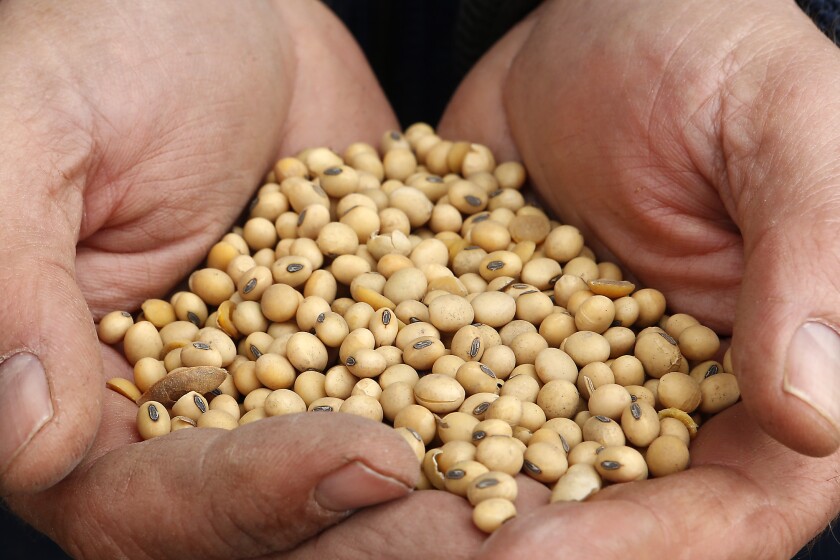On April 4, China announced strong actions against the United States by raising import duties on American farm goods, including soya beans. This decision came after the US placed new tariffs on imports from China and other countries. China responded by adding a 34% tax on all US goods.
China Hits Back with Heavy Tariffs
This came on top of earlier tariffs of 10% to 15% that had already been put on about US$21 billion worth of American agricultural products, including soya beans, in early March.
These added costs make it much more expensive for Chinese companies to buy crops from the US. One of the biggest crops affected is soya beans. Soya beans are an important food for both animals and humans, and they are widely traded between countries. With the new tariffs, it has become harder for China to keep buying large amounts of soya beans from the United States.
A trader based in Singapore explained that with a 34% extra charge, buying from the US just doesn’t make sense anymore. The added cost is so high that many importers in China feel like it’s not even worth trying to bring in those products.
This action by China is part of a bigger trade conflict that started a few years ago. The fight began during the term of a previous US president, when tariffs were first used to pressure China. Now, those same kinds of trade tools are being used again, creating more tension between the two big economies.
Exposed Secrets: Brazil’s Hidden Spy Files Reveal Dark Past
Soya Bean Prices Fall in the US, Rise in Brazil
In the United States, the price of soya beans dropped sharply after China’s announcement. On April 4, the most-traded soya bean contract in the Chicago Board of Trade fell by 34.5 cents to reach US$9.77 per bushel. That’s the lowest price so far for 2025. Traders and farmers in the US are worried because China is one of the biggest buyers of US agricultural products, and a major customer for soya beans.
When China steps away from buying US soya beans, other countries step in to fill the gap. Brazil, which is already a large exporter of soya beans, is now seeing more demand from Chinese buyers. Brazil has had a good crop this year, meaning they have a lot of soya beans to sell. Thanks to that, they are expected to ship a record amount of soya beans to China during the second quarter of the year.
This rise in demand has also led to a rise in prices. On April 3, Brazil’s port prices for soya beans jumped to one dollar per bushel above the US benchmark. That means that even though Brazil’s prices are now higher, Chinese importers are still more willing to buy from Brazil than from the US because of the new tariffs.
China’s Veiled Warning to US; WZ-9 Drone Could Detect F-35 and B-21
Other countries like Argentina and Paraguay also grow soya beans and are expected to gain from this shift. For wheat, countries like Australia and Argentina are becoming stronger suppliers to China as well.
Farmers in Brazil are being encouraged to grow more soya beans. Even though Brazil has already produced a large amount this year, the ongoing trade tensions are giving them a reason to expand their planting further. This might help them keep up with the strong demand coming from China, especially since US imports are now heavily taxed.
Additional Chinese Measures and US Export Losses
China has also taken other steps beyond just tariffs. On April 4, the Chinese government cancelled some paperwork needed to import sorghum from the US. Sorghum is another farm crop used in food and animal feed. The cancellation was explained as a food safety issue. The affected shipments came from companies that are either American or have Chinese ownership.
U.S. Tariffs Deal Heavy Blow to Hyundai and Samsung
Along with sorghum, China also stopped importing certain poultry items. These include poultry meat and bone meal, which are used for animal food. Imports from several US companies were halted, and approval documents were taken back. This move blocks more American agricultural goods from entering China.
Even before this new wave of trade restrictions, China had already been buying less from the US. In 2024, the total value of farm goods China bought from the US dropped to US$29.25 billion. That’s a big fall from US$42.8 billion in 2022. This means the United States has been steadily losing one of its most important customers for farm exports.
These developments mark a deepening of the trade struggle between the two countries. The extra costs and blocks on US goods are now pushing China to depend more on other suppliers. Meanwhile, American farmers and trading companies are left dealing with lower prices and fewer buyers. Countries in South America, especially Brazil, are stepping in to take a larger share of the market that the US is losing.

